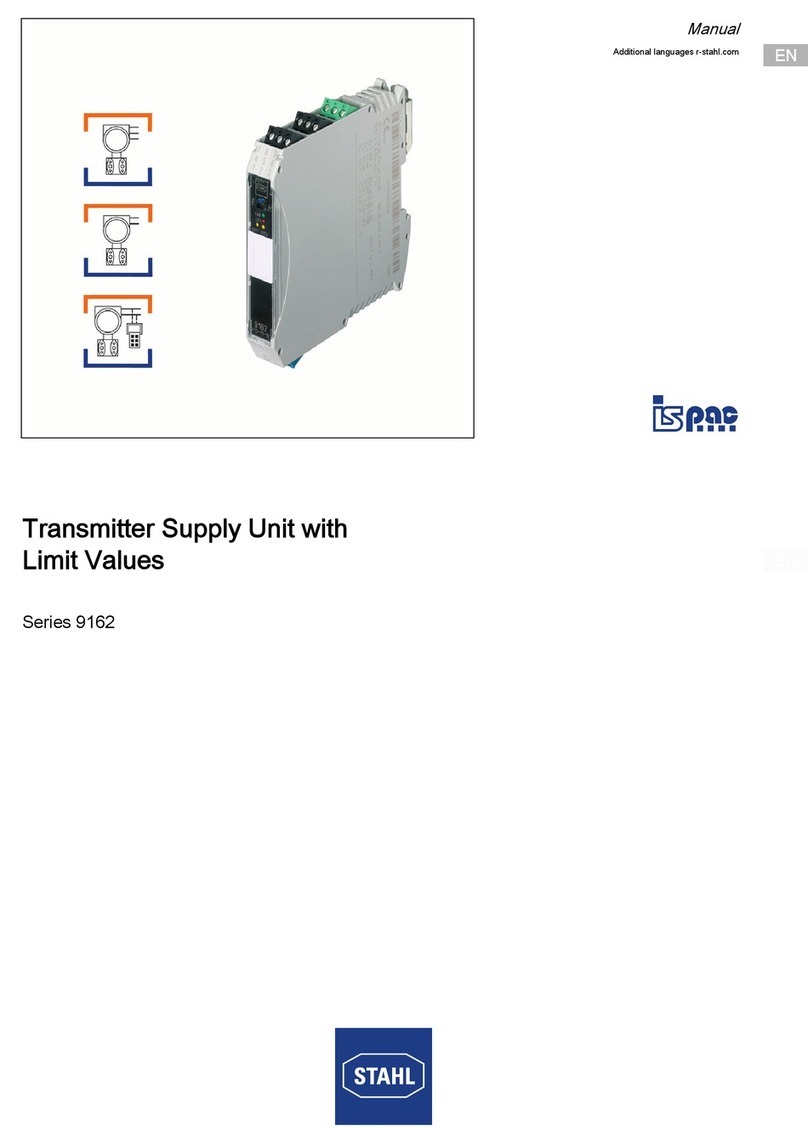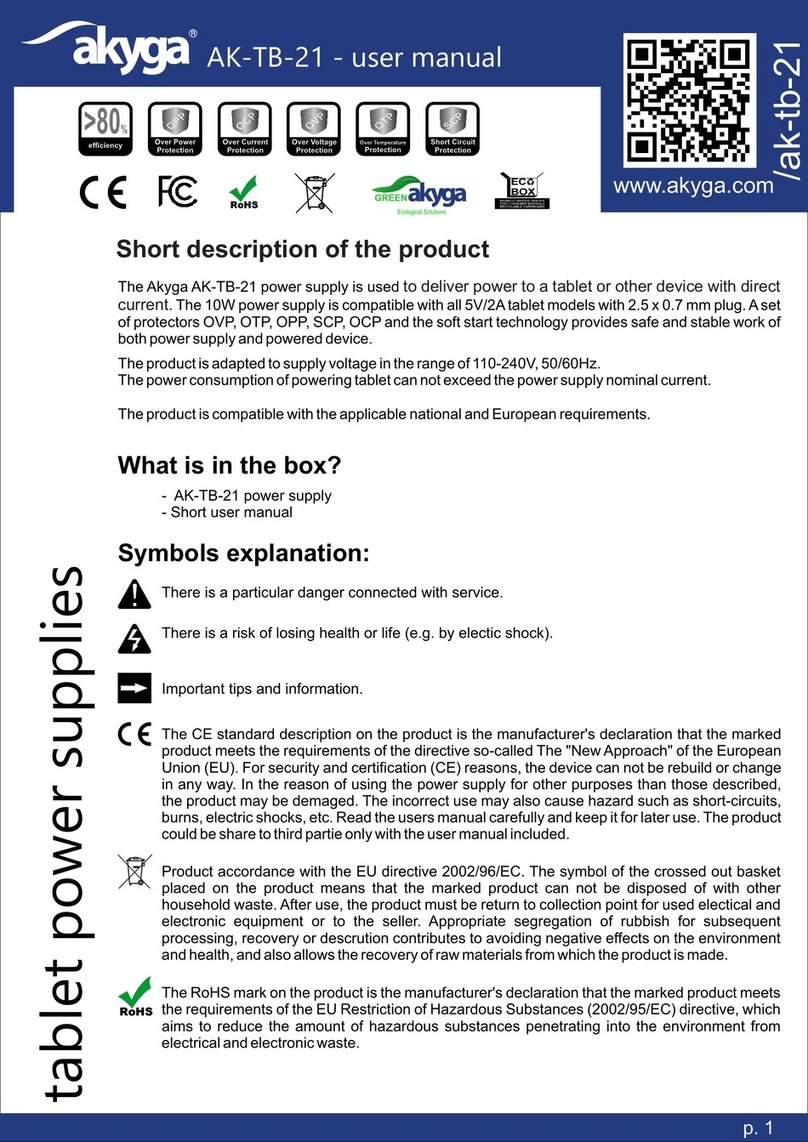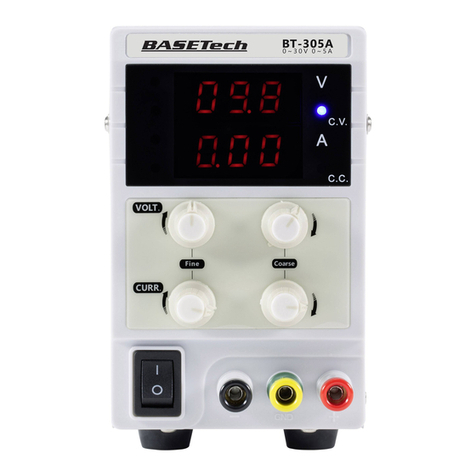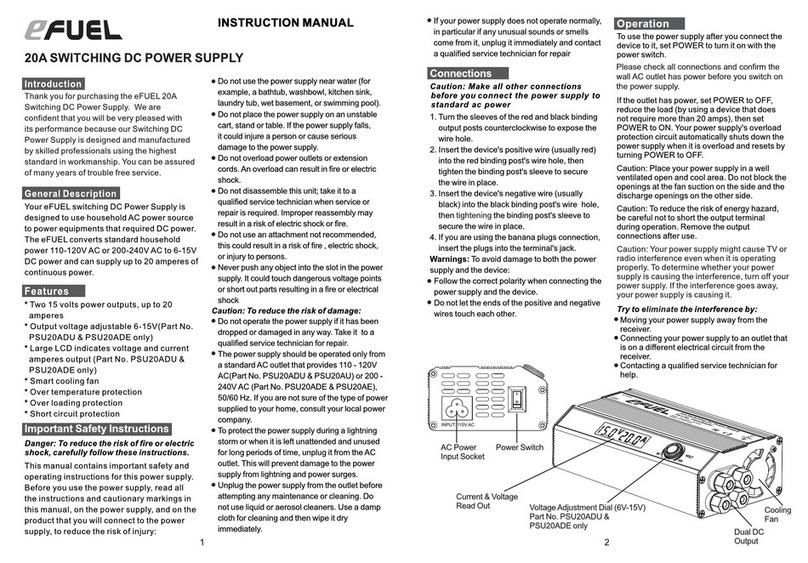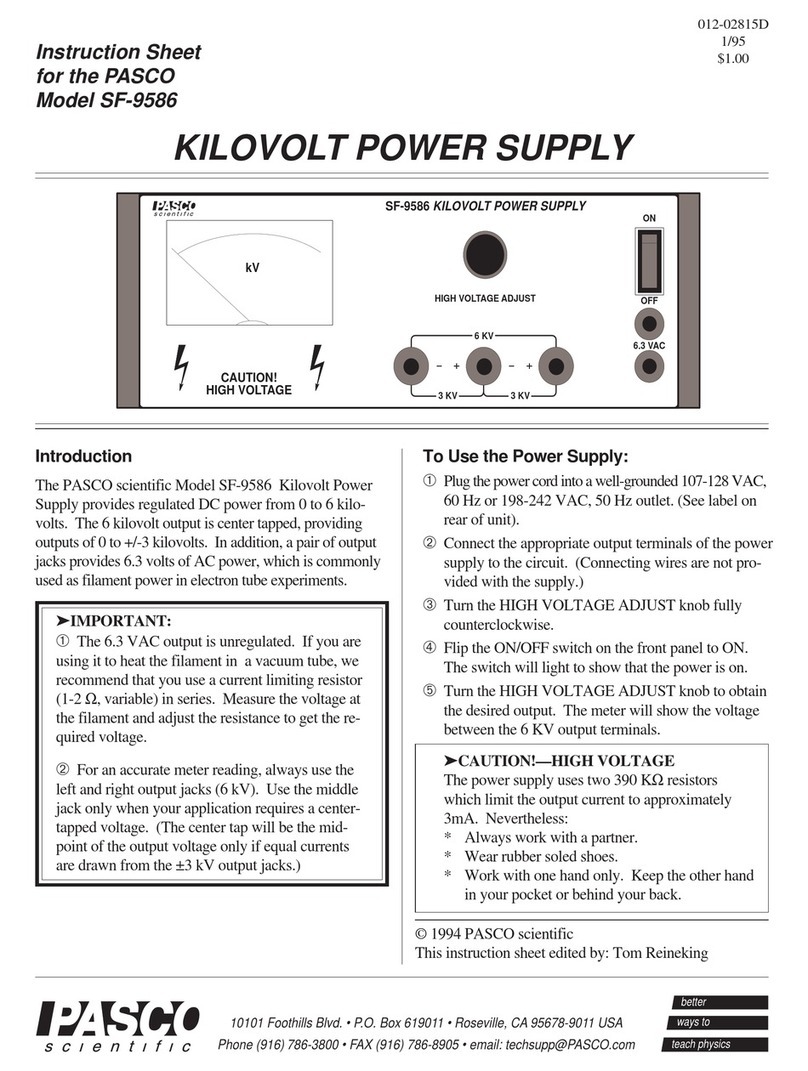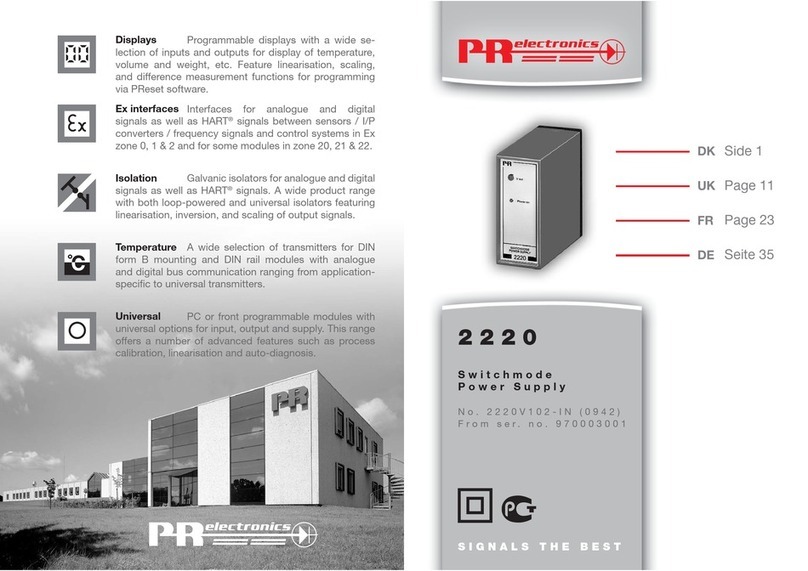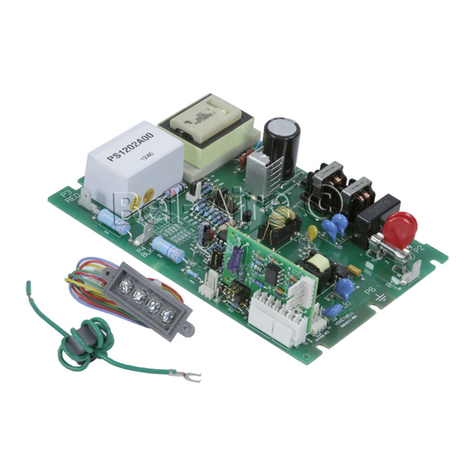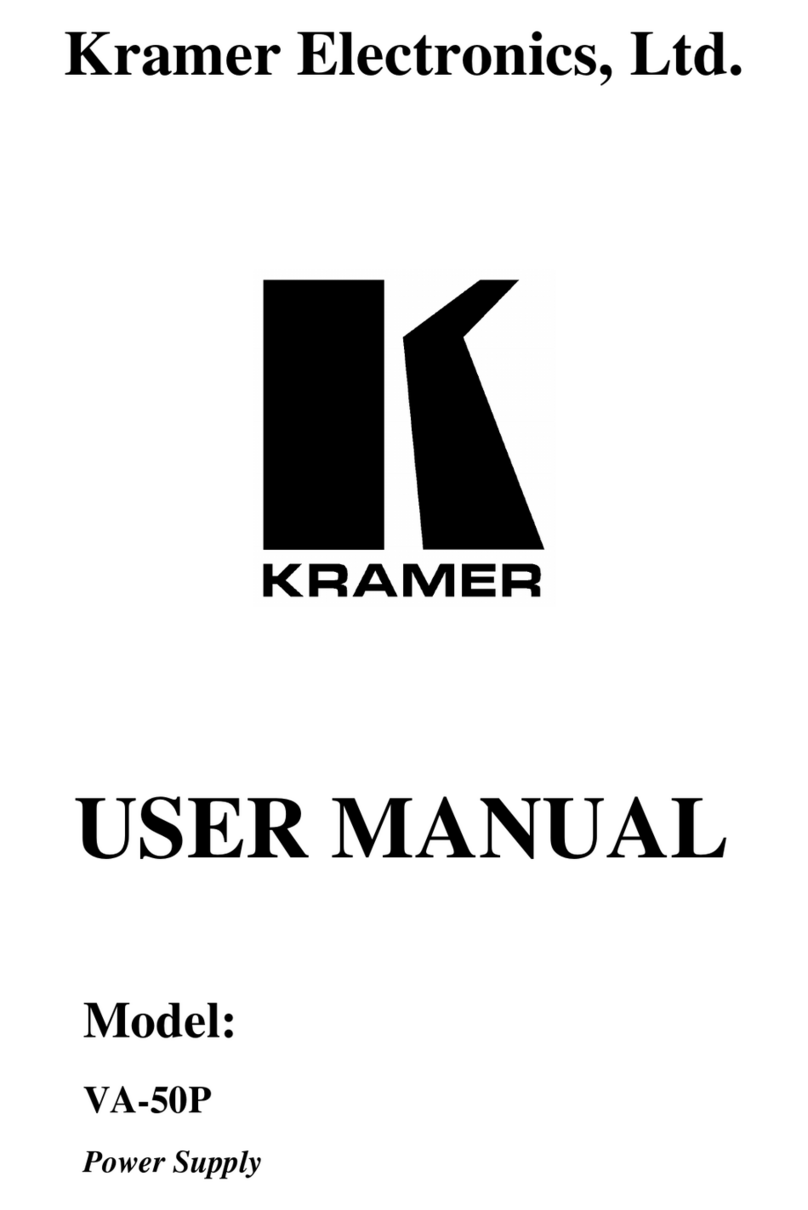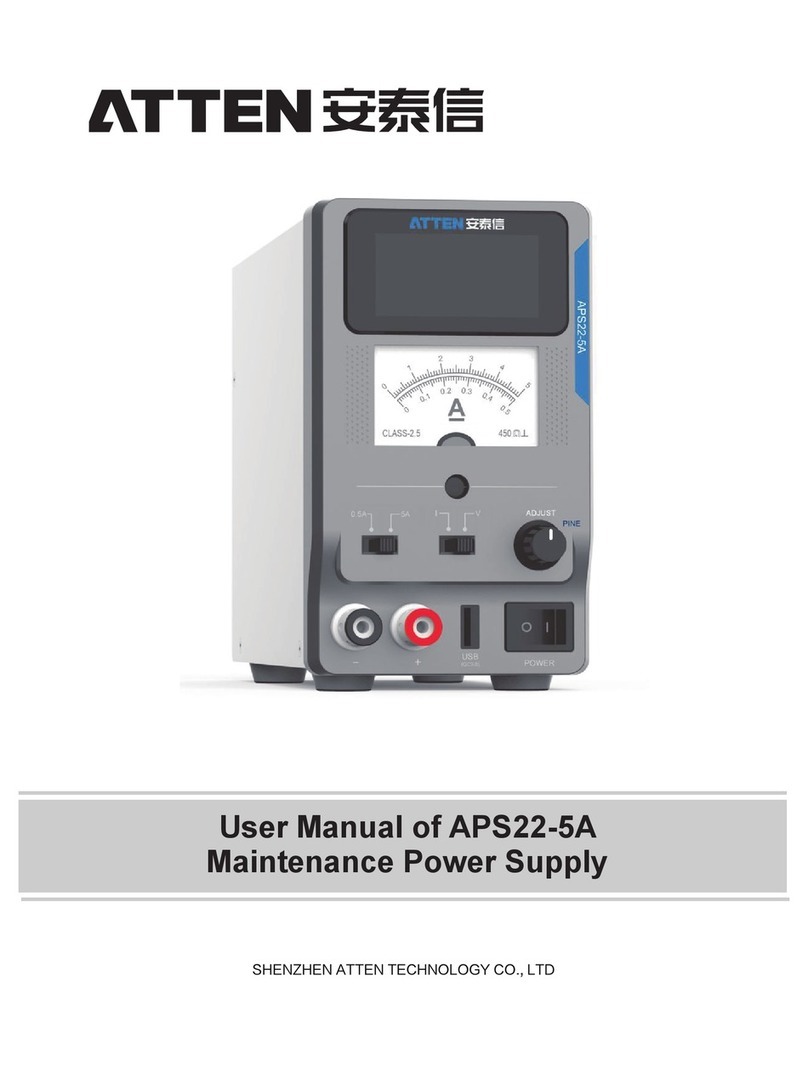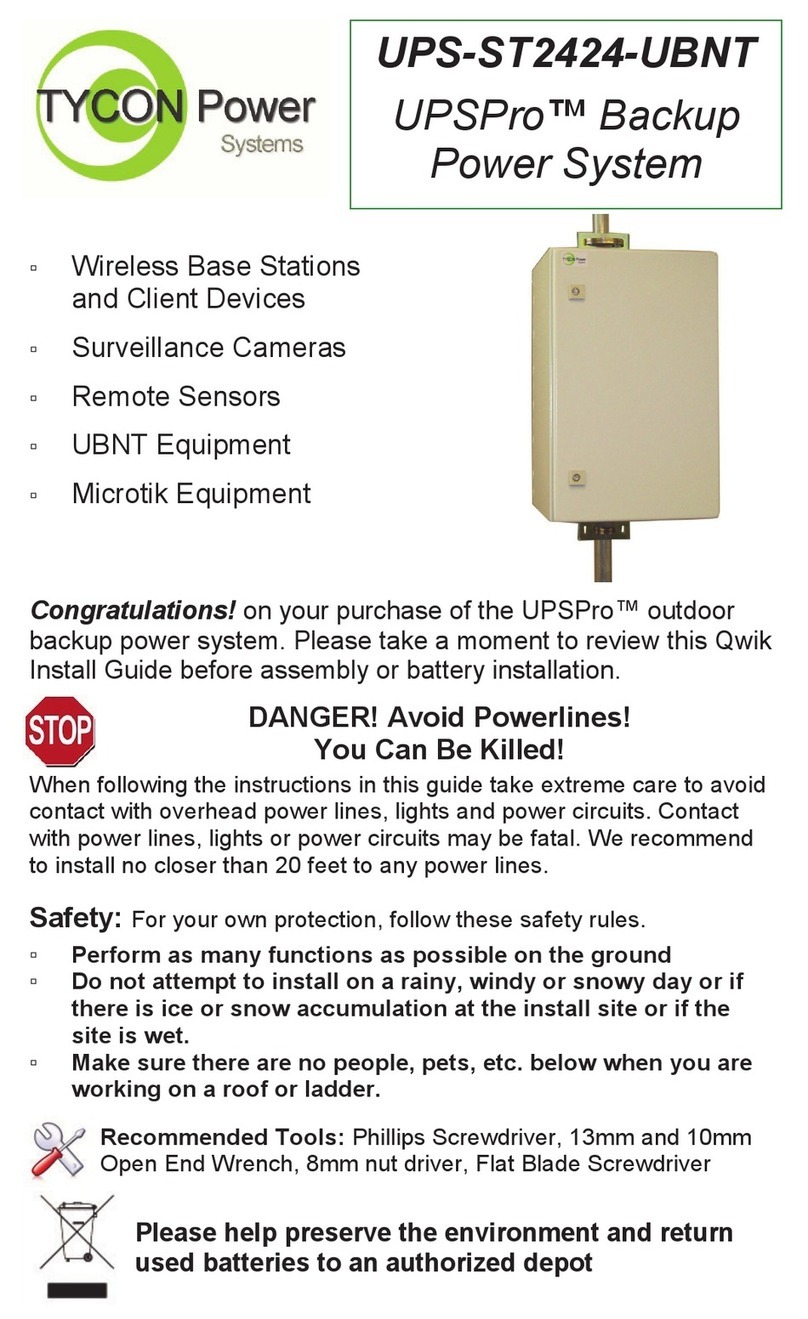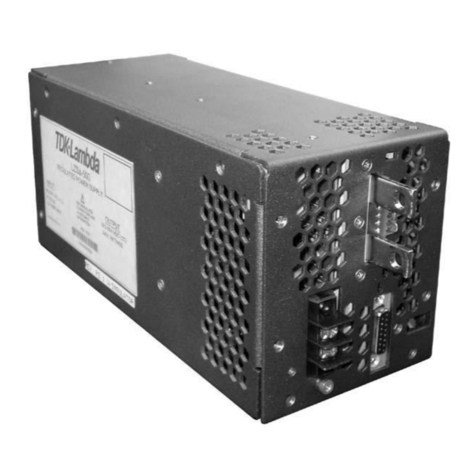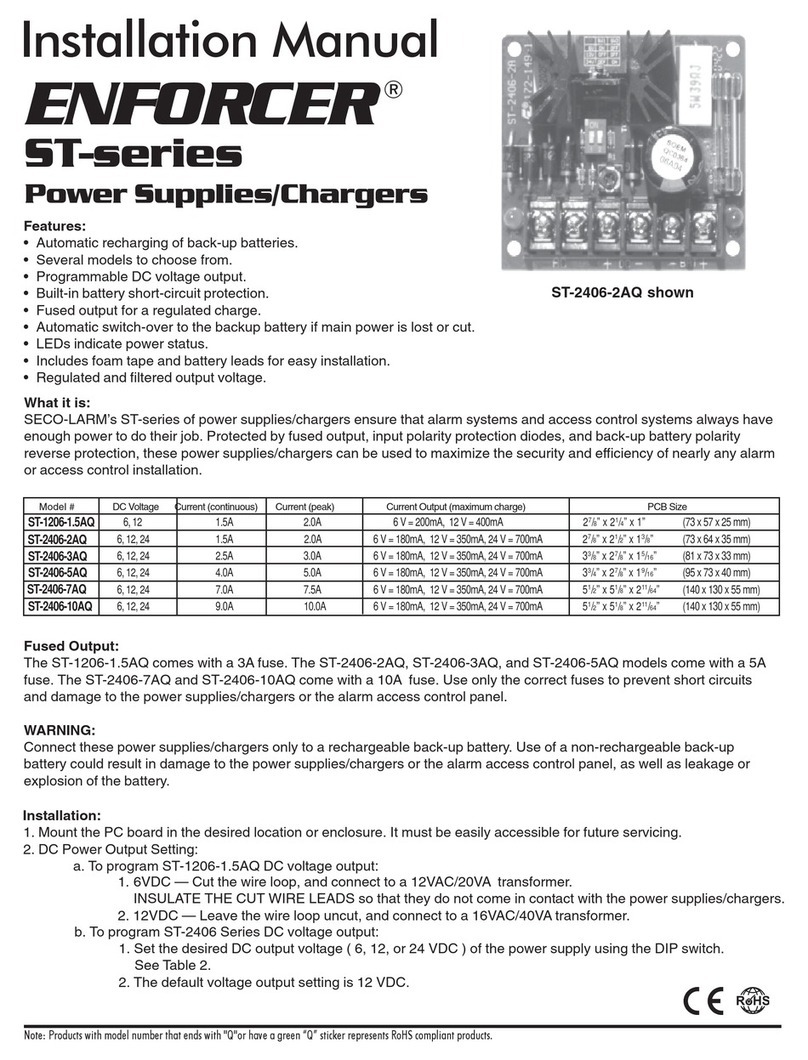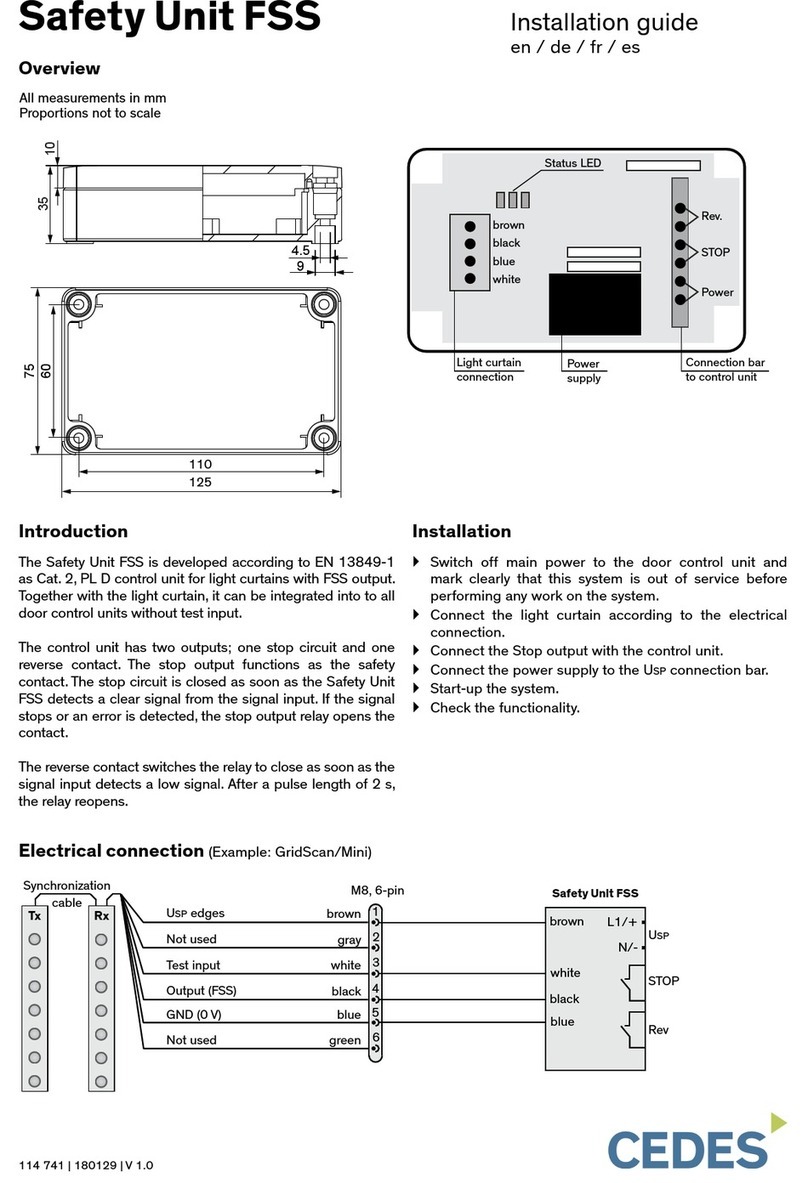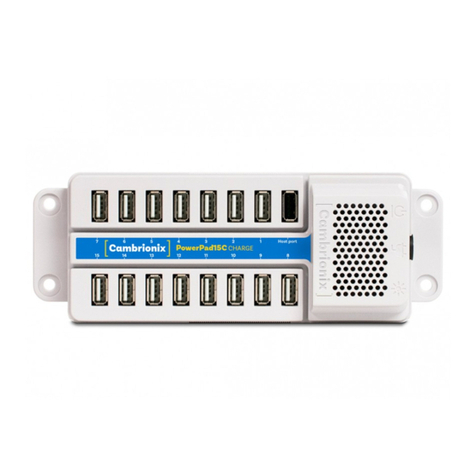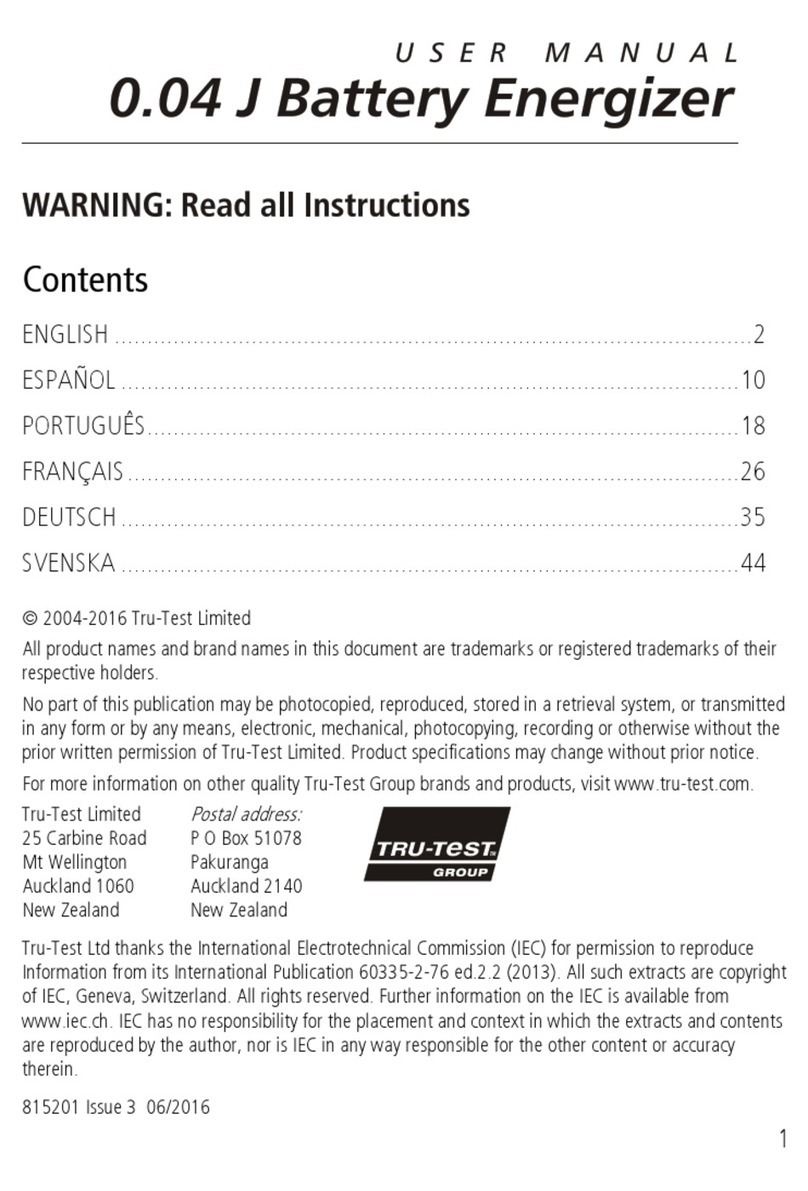Fortis SG200 User manual

FORTIS SG200
SOLAR ENERGISER
USER MANUAL
Viridis House, Toppesfield Road
Finchingfield, Essex, CM7 4NZ
01376 503869
customercare@sure-green.com

2
Contents
Introduction.............................................................................................3
1. Important safety introduction..............................................................3
2. Specification.........................................................................................6
3. Installation guide .................................................................................6
4. Troubleshooting...................................................................................9
5. Guarantee............................................................................................9
Contact Information...............................................................................10

3
Introduction
Thank you for buying Suregreen’s FORTIS electric fence energiser. This energiser has built-in lightning
protection devices to reduce the incidence of lightning damage, and built-in RFI (Radio Frequency Interference)
Suppressed Circuitry.
You must read this manual carefully before using this product. Please retain this manual for your records.
If you have any questions regarding this product, please get in touch:
•customercare@sure-green.com
•01376 503869
This manual is for FORTIS SG200 solar electric fence energiser.
1.Important safety introduction
Symbol meaning:
Separate supply unit
Connection to mains-operated equipment prohibited, including battery chargers
Read user manual before use
Weather resistant/resistant to splashing water
High voltage
Cannot recycle directly
Satisfies CE requirements
Satisfies Rohs requirements
WARNING: Please ensure you read the following installation requirements
and regulations in their entirety.
⚫Unless the high/low voltage output is disarmed, do not touch live electric fence.
⚫Do not let this energiser get significantly wet.

4
⚫This product must be placed or installed in cool and breezy place. It’s strongly recommended that you
avoid placing it in direct sunlight.
⚫This fence is used to prevent the migration of wildlife and livestock. It is not designed for any other use.
⚫Make sure the guard is earthed.
⚫Make sure that the fence wire does not touch grass or wood. It is necessary to occasionally cut the grass
around the fence wire, but be careful of the wire when doing so.
⚫You must ensure that you check the batteries at regular intervals. Please replace the batteries when the
BAT light (battery caution light) is illuminated. Take out the batteries when this fence is not in use,
otherwise this can cause leakage.
⚫Do not climb over, through or under a multi-wire electric fence. Use a gate or a specially designed crossing
point.
⚫Avoid electric fence constructions that are likely to lead to the entanglement of animals or persons.
⚫Electric animal fences must be installed and operated so that they cause no electrical hazard to persons,
animals or their surroundings.
⚫In all areas where there is a likely presence of unsupervised children who will be unaware of the dangers
of electric fencing, you must ensure that a suitably rated current-limiting device (having a resistance of not
less than 500 ohms) is connected between the energiser and the electric fence in this area.
⚫This appliance is not intended for use by young children. Please supervise young children around the
electric fence and energiser at all times to ensure they do not play with the appliance.
⚫Do not place combustible materials near the fence or energiser connections. In times of extreme fire risk,
disconnect the energiser immediately.
⚫Do not tamper with, dismantle or make any changes to the energiser. Do not touch the high voltage part,
otherwise you may get an electric shock.
⚫An electric animal fence must not be supplied from two separate energisers or from independent fence
circuits of the same energiser.
⚫For any two separate electric fences, each supplied from a separate energiser which is independently
timed, the distance between the wires of the two electric animal fences must be at least 2.5m. If this gap
is to be closed, this must be using a non-conductive material or an isolated metal barrier.
⚫Barbed wire or razor wire must not be electrified by an energiser.
⚫A non-electrified fence incorporating barbed wire or razor wire may be used to support one or more off-
set electrified wires of an electric animal fence. The supporting devices for the electrified wires must
ensure that these wires are positioned at a minimum distance of 150mm from the vertical plane of the
non-electrified wires. The barbed wire and razor wire must be earthed at regular intervals.
⚫Where an electric animal fence crosses a public pathway, a non-electrified gate must be incorporated in
the electric fence at that point, or a crossing point or safe stiles must be provided. At any such crossing,
the adjacent electrified wires must carry warning signs.
⚫In areas of public access, you must use an electric fence warning sign every 10m (33ft) to identify the
electrified wires.
⚫Wherever possible, avoid crossing with overhead power lines. If such a crossing cannot be avoided, it

5
should be made underneath the power line and as near as possible to right angles.
⚫If connecting leads and electric fence wires are installed near an overhead power line, the clearances
should be not less than those shown below:
Power Line Voltage
V
Clearance
M
≤1000
>1000 ≤33000
>33000
3
4
8
⚫If connecting leads and electric fence wires are installed near an overhead power line, their height above
the ground should not exceed 3m.
This height applies either side of the orthogonal projection of the outermost conductors of the power line
on the ground surface, for a distance of:
- 2m for power lines operating at a nominal voltage not exceeding 1000V;
- 15m for power lines operating at a nominal voltage exceeding 1000V.
⚫Electric animal fences intended for deterring birds, containing household pets or training animals such as
cows need to only be supplied from low output energisers to obtain a satisfactory and safe performance.
⚫In electric animal fences intended for deterring birds from roosting on buildings, you must not connect any
electric fence wire to the energiser earth electrode. A warning sign must be fitted to every point where
persons may gain access to the conductors.
⚫Fence wiring should be installed well away from any telephone or telegraph line or radio aerial.
⚫The size of any warning signs must be at least 100mm x 200mm.
⚫The background colour of both sides of the warning sign must be yellow. The text must be black and must
read:
- something similar to “CAUTION: Electric Fence” and/or,
- the symbol shown:
⚫The inscription must be indelible, inscribed on both sides of the warning sign and have a height of at least
25mm.
⚫Ensure that all mains-operated ancillary equipment connected to the electric animal fence circuit provides
a degree of isolation between the fence circuit and the supply mains equivalent to that provided by the
energiser.
⚫Weather protection must be provided for the ancillary equipment, unless this equipment is certified by

6
the manufacturer as being suitable for use outdoors, and is of a type with a minimum degree of protection
IPX4.
⚫This energiser complies with international safety regulations and is manufactured to international
standards. Suregreen reserves the right to make changes without notice to any product specification to
improve reliability, function or design.
2. Specification
FORTIS SG200 solar-powered electric fence energizer components:
Power Source
12V, 7.2AH rechargeable lead-acid battery
Maximum Output Voltage
Up to 8.5 KV
Voltage under 500ohm
Up to 2.5KV
Energy
0.15 J
Stored Energy
0.2 J
Unless otherwise stated, values are typical and normal production tolerances of ±10% should be allowed for.
3.Installation guide
Installing the battery
1. Top case
2. Screw for solar panel fixing
3. Solar panel
4. PCBA
5. PCBA cover
6. Battery box
7. Battery
8. Battery holder
9. EVA foam
1. Place the energiser on a flat surface. Open the
battery compartment using a screwdriver (see
diagram).
2. Insert the battery.
3. Connect the positive (red) lead to the positive (+)
terminal on the battery.
4. Connect the negative (black) lead to the negative
(–) terminal on the battery.
5. Close the battery compartment.

7
CAUTION: When connecting the battery, be careful not to short-circuit the supply terminals.
POSITIONING THE ENERGISER
Install the energiser:
•Adjacent to the electric fence
•Preferably in the middle of the electric fence
•Where it will receive the most daily sun throughout the season
•Where a good earth can be obtained
•On firm ground away from flooding and out of reach of animals and children (inside a protective fence, if
required)
•The solar panel should face true north in the southern hemisphere and true south in the northern
hemisphere.
MOUNTING THE ENERGISER
The energiser can be mounted directly onto a steel Y-post or T-post using the post-mounting slot. To mount
onto a wooden post, use the hardware provided.
•Thread washers onto the nails.
•Space the nails 75 mm (3”) apart (or one nail-length).
•Hammer in the nails, allowing them to protrude by 10 mm (3/8”).
•Slide the energiser onto the nails with the washers inside the post-mounting slot.
CONNECTING TO AN ELECTRIC FENCE
1. Push a 1 m (3’3”) earth rod fully into firm ground.
2. Connect the black lead from the fence earth terminal on the energiser to the earthing system.
3. Connect the red lead from the fence output terminal on the energiser to the fence. Make sure that there is
good contact.
CAUTION: Make sure the connecting leads drop downwards from the energiser to prevent water from collecting
at the terminals.
OPERATION
The pulse indicator light flashes once for each output pulse.
When switched off, the pulse indicator light stops.

8
Battery protection model
The intelligent battery management feature puts the energiser into Battery Protection Mode when the battery
charge falls below a safe operating level. When in Battery Protection Mode, the energiser is still on, but it will
not deliver a pulse to the electric fence.
The energiser will resume delivering pulses when the solar panel has recharged the battery so that it is above
the safe operating level.
Alternatively, the battery can be disconnected and recharged with a battery charger, then returned to the battery
compartment and reconnected.
BATTERY INFORMATION
Battery charging
The solar panel can fully charge a flat battery in three days, provided that the energiser is switched off and there
is adequate sunlight. The battery can also be charged using a 14.4V battery charger suitable for charging
rechargeable lead-acid batteries. This should have an output voltage of 14.4V and output current not exceeding
1A.
When fully charged, the battery should be able to power the energiser for over three weeks with no sunlight.
Replacing the battery
If a replacement battery is required, use a 12V, 7.2Ah, rechargeable lead-acid battery.
Do not use a non-rechargeable battery.
Do not dispose of the battery in a landfill or in a fire.
In the event of a spill or leakage from a lead-acid battery
Wear acid-resistant clothing, boots, gloves and a face shield. Contain small spills with dry sand, earth and
vermiculite. Do not use combustible materials. If possible, carefully neutralise spilled acid with soda ash, sodium
bicarbonate, lime, etc. Do not let acid get into the sewerage system.
Neutralised acid must be managed in accordance with approved local, state and federal requirements. Consult
your relevant environmental agency.
ENERGISER MAINTENANCE
Clean the solar panel regularly with a soft cloth using glass cleaner or a mild solution of detergent and water.
This ensures the solar panel functions efficiently.
When transporting the energiser, protect the solar panel to prevent the glass surface from being damaged.
Energiser storage
If the energiser is stored for an extended period, the battery may discharge and become damaged. The energiser
should be stored inside, next to a window, where sunlight can shine on the energiser each day. If the energiser
cannot be stored in a sunny position, it should be kept in a cool place. The battery should be fully charged and
disconnected from the energiser.
The battery should be recharged manually every six months using a suitable 14.4 V battery charger.

9
4. Troubleshooting
Warning: Do not tamper with, dismantle or reassemble the guard.
Fault
Solution
The Pulse indicator light is
flashing, but the electric shock
delivered by the fence is weak.
Check that all connections in the fence and earth system are firm and secure.
If necessary, clean away any corrosion.
Check that the earth rod is pushed firmly into firm ground.
Check for faults along the fence line caused by trees or vegetation. If
necessary, remove obstructions and mend the fence.
Check that the energiser is adequate for the length of the fence. If necessary,
reduce the length of the fence or reduce the number of fence wires.
Alternatively, divide the fence-line into smaller zones, with each zone
powered by a separate energiser.
The Pulse indicator light is not
flashing.
Check that the energiser is switched on.
If there has been insufficient sunlight to charge the battery, the energiser may
be in Battery Protection Mode. Charge the battery by placing the energiser in
full sunlight with the solar panel facing true north in the southern hemisphere
and true south in the northern hemisphere.
Ensure the battery is connected correctly with the positive (red) lead to the
positive (+) terminal on the battery and the negative (black) lead to the
negative (–) terminal on the battery.
Try charging the battery manually using a suitable battery charger.
Replace the battery with a new battery. Before installing a new battery, charge
it fully using a suitable battery charger.
The battery needs frequent
replacement.
Check that the solar panel is clean and is not damaged. Make sure the
energiser is positioned to receive maximum sunlight. If necessary, remove any
objects or vegetation that might be casting a shadow on the energiser.
5.Guarantee
We grant a warranty of 2 years as standard which begins from the date of purchase marked on your invoice.
We will only perform warranty services when the faulty unit is returned to us together with a copy of the invoice.
The unit should be returned in its original or equivalent packaging, please ensure that you retain this and ensure
that the label on the unit is fully legible. New shipping charges will apply.

10
If these requirements are not fulfilled, we reserve the right to deny warranty services.
Warranty claims are excluded for direct or indirect damage due to:
1) Being beyond the warranty date;
2) Being without the serial number;
3) Transport damage;
4) Improper use, operation and refitting;
5) Non-observance of the relevant safety instructions, or operation of the energiser in an environment which
is different to what is described or recommended within this manual;
6) Installation and operation of the energiser outside of the relevant international standards;
7) Influence of foreign objects and force majeure (lightning strike, overvoltage, severe weather, fire etc.).
The design and specification shall be subject to any due changes without prior notice. The final
interpretation right of this event is reserved by Suregreen.
Contact Information
If you have any further questions or queries, please get in
touch:
Suregreen Limited
www.sure-green.com
Viridis House, Toppesfield Road, Finchingfield, Essex, CM7 4NZ
01376 503869
customercare@sure-green.com
Table of contents
